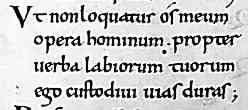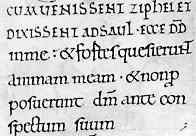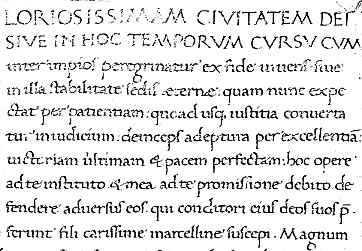 |
|
Scripts and Hands
|
| A script may be defined as the model which a scribe aspires to when he is writing. One scribe may be able to produce a number of different scripts, depending on the purpose for which he is writing. A hand refers to the individual peculiarities of the writing of the scribe. Two different scribes may have recognisably different hands, even when they are writing in the same general script. |
 |
 |
| Two segments from the 11th century Harley Psalter (British Library, Harley 603), by permission of the British Library. |
| In the example above, two different 11th century scribes from Christ Church, Canterbury have produced quite recognisably different hands, but both adhering closely to the ideals and template of their script, Caroline minuscule. The relationship between scripts and hands is quite important for the decoding of handwriting. So often an individual sample of writing does not look like any of the models provided in books (or on this website for that matter), if it is examined in a purely intuitive way, so it is necessary to try to pull it apart, not just to classify it, but to work out how to decode it. |
| To examine this problem, we have to look at why handwriting models, or scripts, exist in the first place, how they are perpetuated and taught, how rigidly they are enforced and why they change. This gets right down to the social significance of the act of writing, as opposed to the significance of what is written. Writing is a material culture artifact. Along with this, we have to consider just how scripts are classified; what criteria are used, how rigidly they are expected to adhere to the model. I have discussed this issue to a degree in another section Why Paleography Sucks. That section concentrates rather on the problems of paleographical classification; this section is hopefully more of a working guide to how you can use it, despite its problems, in the course of trying to decipher that piece of parchment in front of you. |
The criteria used to define named scripts can be quite complex, and not always consistent. At the root of the matter are the basic letter forms, including variants of individual letters and the use of ligatures which can change letter forms. Not all of the letters of the alphabet are equally diagnostic for the identification of scripts, and usually certain letters are picked out to differentiate particular scripts. |
| For example, the letter o rarely has any unique characteristics. |
           |
| The letter g however, turns up with a range of distinctive forms. |
           |
| Other criteria which have been used to define scripts include the angle at which the scribe has held the pen, and the ductus or sequence of strokes used to create the letter. Then there are questions of style; wide or narrow, round or pointed, angular or rounded, short or tall ascenders and descenders, neat and workmanlike or curly and extravagant. Now if you put all these togther, you would have an infinity of different handwriting styles, or if not an infinity exactly, you would have to multiply all the scribes there have ever been by all the styles that each could write in. Not useful. So we group them into clusters that have certain charateristics in common, and call these scripts. How closely each hand conforms to the type of the script to which it belongs depends on a number of factors, which might include the education of the scribe, the expectation of conformity in relation to the text that the scribe is writing, and the social environment in which the scribe is writing. |
| There is also the question of history. Paleographical nomenclature relates as much to the time, place and circumstance of production of a script as it does to what it looks like. |
 |
This is a segment from a late 15th century copy of De Civitate Dei of St Augustine, produced in Italy, probably in Naples (British Library, add. ms. 15246, f.29). |
| The example above conforms to all the structural and stylistic criteria that define the examples of Caroline minuscule at the top of the page, but we do not call it Caroline minuscule, we call it humanistic minuscule. Why? Because it was not written in the 10th or 11th centuries, but in the 15th century in Italy. We apply an overlay of historical circumstance to the visual criteria in order to define a script. In the converse of this, almost everything that was written between the 12th and 15th centuries (except 15th century Italy) in a whole range of variant styles from square to round, formal to cursive, and every kind of hybrid in between, with a range of variant letter forms, tends to get dubbed with the basic designation of Gothic. A range of modifiers to the script name might get us closer to what it actually looked like, but that was when and where Gothic was, so that is what we call it. |
| To untangle this muddle, we must look at the circumstances in which the various named varieties of scripts were taught and used. |
|
 Reading Manuscripts Reading Manuscripts |
 Why Read It?
Why Read It? |
|
 |
 |























